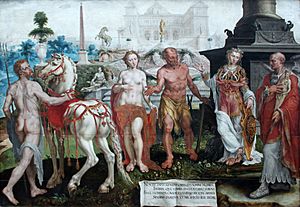Momus facts for kids

Momus is a fascinating figure from Greek mythology. He is known as the god of blame, criticism, and mockery. Imagine someone whose main job is to find fault with everything!
Momus is the son of Nyx, who is the goddess of Night. Unlike many other gods, he doesn't have a father mentioned in the myths. He was eventually kicked out of Mount Olympus, the home of the gods, because he kept criticizing powerful gods like Zeus and Aphrodite.
Contents
Who is Momus?
The God of Blame
Momus is the personification of blame and fault-finding. He represents the spirit of criticism. In ancient stories, he was often shown as someone who could never be pleased. No matter how perfect something seemed, Momus would always find a flaw.
His role was to point out mistakes, even if they were small. This made him a unique, and sometimes annoying, character among the gods. He was always ready with a sharp comment or a sarcastic remark.
Born from Night
Momus's mother is Nyx, the ancient goddess of Night. Nyx is one of the oldest and most powerful deities in Greek mythology. She was present at the very beginning of creation.
Being born from Nyx means Momus comes from a very early and mysterious part of the cosmos. This also suggests his critical nature might be as old as the world itself.
Why Was Momus Banished?
Criticizing the Gods
Momus was famous for his sharp tongue. He often criticized the creations and actions of other gods. One famous story tells how he found fault with the works of three great gods.
He criticized Hephaestus for not putting windows in man's chest. This would have let everyone see a person's true thoughts! He also found fault with Athena's house and Poseidon's bull.
His biggest criticisms were aimed at Zeus and Aphrodite. He said Zeus's bull should have had eyes on its horns. He also mocked Aphrodite's beauty, saying her sandals squeaked. This constant negativity eventually led to his banishment from Olympus.
Life After Olympus
After being kicked out, Momus lived away from the other gods. His banishment highlights that even gods have limits to how much criticism they can handle. It also shows that constant negativity can lead to isolation.
Despite his banishment, Momus's character continued to appear in stories. He became a symbol for those who are overly critical or find fault in everything.
Momus in Stories
Aesop's Fables
Momus appears in some of Aesop's Fables, which are short stories with a moral lesson. In these fables, he often plays the role of the fault-finder. He shows how even the best efforts can be met with criticism.
These stories teach us about human nature. They remind us that it's easy to criticize, but harder to create something perfect.
Later Appearances
Momus has also appeared in later literature and art. He is sometimes seen as a figure of satire, used to mock society or politics. His character helps writers and artists point out flaws in a humorous way.
He even inspired characters in plays and performances, like those in the Commedia dell'arte. This shows how his ancient role as a critic continued to be relevant through history.
Images for kids
See Also
 In Spanish: Momo (mitología) para niños
In Spanish: Momo (mitología) para niños


